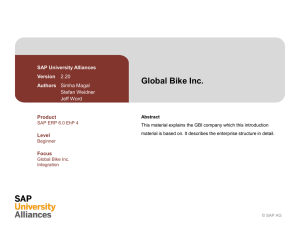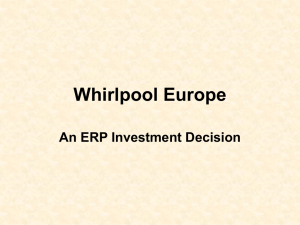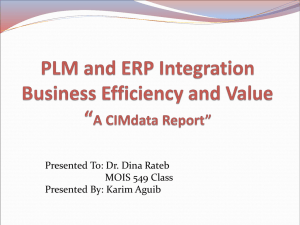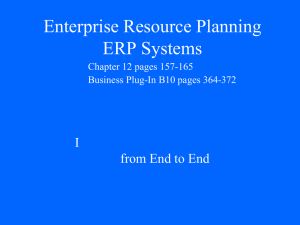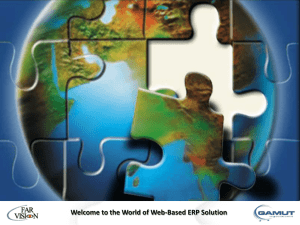Its all ablout integartion
advertisement
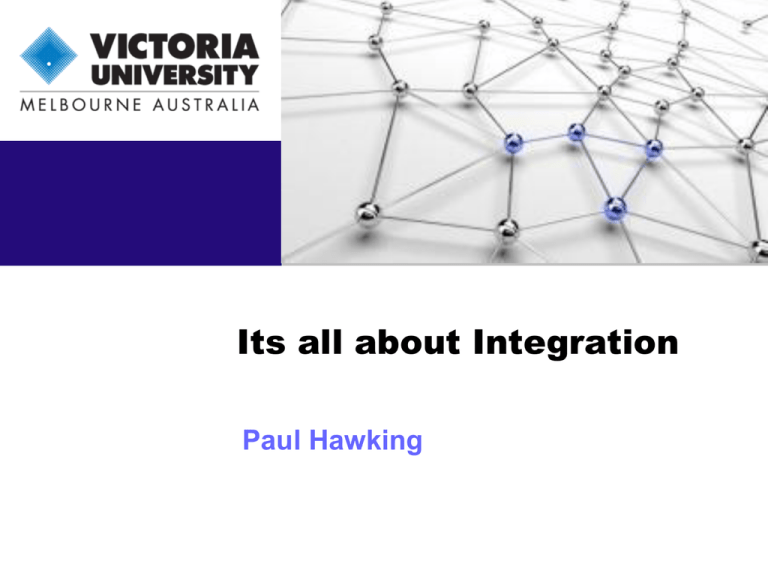
Its all about Integration Paul Hawking Background SAP University Alliance Program (UAP) University SAP SAP User Group Presenter Design Events Advisor Past Chairperson SAP Academic Program Director SAP Mentor 22 SAP million users 2.5 million SAP Community Network members 6,000 active contributors 100 SAP Mentors 1 academic Research Industry Reports Best selling author ERP Systems and Business Intelligence Teach Academics Visiting Professor Develop curriculum 2009 + 2010 Top 10 Most Influential SAP People Who? What? Why? Tim Berners Lee INTEGRATION Journey Business Basics Information Systems ERP Systems Supply Chain Management Business Network Transformation SAP Strategy and Business Processes Business Process Examples Sales Sales Receive Customer Purchase Order Warehouse Prepare Shipment (Pick & Pack) Create Sales Order Send Shipment (Ship) Accounting Create & Send Invoice Recieve Payment $ $ Procurement $ Warehouse Create Requisition Purchasing Create & Send Purchase Order Warehouse Receive Shipment Accounting Receive Invoice Send Payment Business Process Elements Organisational Units Sales Area Distribution Channel Transactions Sales Order Creation Goods Issue Data Master Data Customer Material Transactional Data Sales Quantity Sales Price Process Indicator Journey Business Basics Information Systems ERP Systems Supply Chain Management Business Network Transformation SAP Traditional Business Landscape Executive Management Middle Management Operational Management Operations Sales Production Human Finance & Resources Distribution Traditional Business Landscape Executive Management Middle Management Operational Management Operations Sales Production Human Finance & Resources Distribution Intel (1995) SECURITY HELP RCC ELECTRONIC TRANSFER DAISY PRICE BOOK WMS Configurator CUSTOMER EUC EXTRACTS PNA SARP PRICE NOVA AGREEMENTS INFRASTRUCTURE MDS JAPAN FORECAST CWS JAPAN DAISY STAR JASTAR PGS JAPAN PRICE BOOK PRICE BOOK EDI G/L COMPONENTS COST NIMS EUC EXTRACTS DPA A/P PRODUCT CODE OEM QUOTE MAX RST EUC EXTRACTS DEMAND FORECAST AVAILABILITY EDI EUC EXTRACTS DPA A/R PMS DARE ESTAR CLS AMAPS GPS II DATA WAREHOUSE ISET MPS GIMS Traditional Business Landscape Executive Management Middle Management Operational Management Operations Sales Production Human Finance & Resources Distribution Integration Problems Data • 9/11/2011 • Last name • Subject vs Course Process • Weekly vs Fortnightly • Workflow (goods receipt) People • Application Screens • Information Traditional Business Landscape Executive Management Middle Management Operational Management Operations Sales Production Human Finance & Resources Distribution Public Sector Procurement Process? - Complexity Journey Business Basics Information Systems ERP Systems Supply Chain Management Business Network Transformation SAP Why ERP? Systems Not Y2K Compliant 42% Disparate Systems 37% Poor/Uncompetitive Performance 27% Program Motivation Poor Quality/Visibility of Info 26% Cost Structure Too High 24% Not Responsive Enough to Customers 21% Complex, Ineffective Business Processes 20% Business Processes or Systems Not Integrated 19% Unable to Implement New Business Strategies 15% Business Becoming Global 15% Difficult to Integrate Acquisitions 12% Obsolete Systems 11% Inconsistent Processes 10% Unable to Support Growth 6% 0% Note: Based on multiple answers per respondent 5% 10% 15% 20% 25% 30% 35% 40% % Respondents Source: Deloitte Consulting and Benchmarking Partners (Based on a study of 62 companies that have gone live with an ERP system) 45% ERP Evolution EDI e-Commerce SFA CRM e-business Planning Scheduling SCM Distribution MRP Payroll General Ledger Accounts Payable Accounts Receivable 1970s MRP11 Human Resources Financial Management Information System 1980s ERP ERP11 1990s 2000s What is an Enterprise Resource Planning System? An ERP System can be defined as a “modularised, integrated, real time information system with broad functional scope responsible for the processing and management of business transactions” (Hawking 2005) ERP System Finance Enterprise Resource Planning System Executive Management Human Resources Middle Management Operational Management Sales & Distribution Production Operations ERP Characteristics Links all business processes automatically Reduce inter-processing time (transactions occur one time at the source) Maintain an audit trail of all transactions Utilises a common database Perform internal conversions automatically (tax, foreign currency, legal rules for payroll) Empowers employees by putting data at the fingertips of employees Involve employees in the entire functional cycle Raytheon’s Goals Replace thirty year old non-integrated legacy systems Obtain benefits of business process re-engineering Use ERP to drive integration One time entry and access to information Facilitate achievement of Raytheon Aircraft Company five year plan $19.8 billion in revenues More than 100,000 employees worldwide ERP Example 5,500 SAP users 6 countries 8 major business units Over 40 key systems replaced, including primary manufacturing support system, corporate and field financial and purchasing systems, marketing expense control systems, and project management systems 7,500+ SAP transactions, 100+ reports, 150+ forms, 50+ interfaces to existing systems Benefits Achieved Davenport 2003 SAP R/3 Order Entry IBM Storage Benchmarks - 110 days after production Focus Area 9/1/93 Cycle Time Reengineered Target 10/1/93 SAP Performance 01/20/95 Enter pricing data into system 5 - 80 Days 5 Minutes 5 Minutes Check customer credit upon order 15 - 20 Minutes Automatic Automatic Enter customer order in system 30 Minutes 5 Minutes 15 Minutes % Manual order/ship to total # of orders/ships Generate customer invoice after ship 2 - 23 Days Respond to customer billing inquiry 15 - 20 Minutes Ship evaluation unit from customer request Ship repair/replacement part Credit returned drive Obtain commit date for customer order Unconstrained SJ manufactured drives Allocated; non-SJ manufactured drives 75% 0% 0% 1 Day 8 Hours Real Time Real Time 3 - 30 Days 2 Days 2 Days 3 - 44 Days 2 Days 3 Days 1 - 5 Months 5 Days 10 Days 2 Hrs 3 Weeks Real Time Real Time 2 Hrs3 Weeks Toyota’s Benefits Create Sales /Prod’n Plan Final Prod'n Schedule Create Sales Order Complete Finished Vehicle Enquiry on Vehicle Status Complete Delivery to Dealer Create Invoice to Finance Company Payment From Finance Company Create Retail Delivery Record TOPS POST EXCEL POST BSS VTS VOS BSS ALC VTS BSS VTS VTS VTS MSA MSA VTS ERP ERP ERP ERP ERP ERP ERP ERP POST POST ERP Leadtime O D D D D D D D O Flexibility O O O D O D O O D Cost D D D D D D D D O Lean Org. D D O O O D O O O Systems Current Future ALC Benefits O = No Change D = Improvement X = Detriment ERP Systems and Value Creation Integrate Optimise Informate ERP Evolution Journey Business Basics Information Systems ERP Systems Supply Chain Management Business Network Transformation SAP Supply Chain Supply Chain Challenges Forces Driving the Evolution of the SCM Forces of Change Globalization Worldwide reach is not a competitive advantage but a necessity Cost Leadership Cost targets and industry consolidation Innovation Suppliers need to be involved earlier in product development Outsourcing Focus on core activities, trusted partnership Forces Driving the Evolution of the SCM Retailer Traditional Clothing Retailer Zara Time to Market 36 weeks 4 weeks Forces Driving the Evolution of the SCM North American Glass Suppliers 2001 2006 Owens-Illinois Owens-Illinois Corning Consumers Anchor Hocking Software Company Consolidation Forces Driving the Evolution of the SCM Date Entry Price May 2002 Coca Cola ‘Vanilla Cola’ $2.87/6-pack May 2003 Sam’s Choice $1.00/6-pack ‘Vanilla Cola’ August 2003 Pepsi ‘Vanilla Cola’ $1.99/6-pack Key Industry Trends Quick Copying Erodes Price and Market Share Proctor &Gamble introduces Product Date Price Swiffer 1999 $9.62 Pledge 1999 $7.32 2001 $7.09 2002 $6.69 Grabber Magic Sweeper kit Clorox Ready Mop 37% Price Decline Forces Driving the Evolution of the SCM Focusing on Core (Moore) Core: Processes that create unique competitive differentiation Source of growth in revenues and profits Context: All other processes No prize for doing these well But there are penalties for doing them poorly This is not the same as your core competence This is not the same as your core business Journey Business Basics Information Systems ERP Systems Supply Chain Management Business Network Transformation SAP Business Network (Moore) Business networks are core/context ecosystems Each member contributes a unique core—their “claim to fame” Every other member supplies the context to support that core Business network create higher returns Differentiating spend is greater, duplicated spend is less Higher differentiation creates higher returns on capital for all Business networks are competitive weapons Silicon Valley, New York, Milan, Bangalore, Shanghai The Internet has made this a “virtual” phenomenon Dell Business Network Business Networks: A Dell Laptop for Thomas Friedman 1 13 20 17 5 10 21 19 16 12 9 17 6 8 14 3 11 Wireless card* 15 2 18 4 1. 2. 3. 4. 5. 6. 7. 8. 9. 10. Laptop was designed Order was taken by phone Order hit the Dell factory Intel microprocessor* Memory * Graphics card* Cooling Fan* Motherboard* Keyboard* LCD* 11. 12. 13. 14. 15. 16. 17. 18. 19. 20. 21. Modem* Battery* Hard Drive* CD/DVD drive* Notebook bag* Power adapter* Power Cord* Memory stick* Repackaged Sent to Tom Friedman Total order lead time was 13 days. The order was delayed 9 days because of a Wireless card “control issue”. Total supply chain estimated at 400 companies in North America, Europe, & Asia. Dell Laptop Story 1. 2. 3. 4. 5. Laptop was designed jointly in Austin, TX and Taiwan Order was taken by Mutjeba Naqvi over Dell’s 800 number Order hit the Dell Factory in Penang, Malaysia Intel microprocessor came from either Phillipines, Costa Rica, Malaysia, or China Memory from either Samsung in Korea, Nanya in Taiwan, Infineon in Germany, or Elpida in Japan 6. Graphics card from MSI or Foxcom both in China 7. Cooling Fan from CCI or Auras both in Taiwan 8. Motherboard from Samsung or Quanta, both in Shanghai, or Compal or Wistron in Taiwan 9. Keyboard from Alps, Sunrex, or Darfon, all in China 10.LCD from Korea, Japan, or Taiwan 11.Wireless card from Malaysia, Taiwan or China 12.Modem from China 13.Battery from Mexico, Maylasia, China, Taiwan, or Korea 14.Hard Drive from Singapore, Thailand, or Phillipines 15.CD/DVD drive from Indonesia, Philippines, China, or Malaysia 16.Notebook bag from China 17.Power adapter from Thailand, Taiwan, Korea, or China 18.Power Cord from India, China, or Malaysia 19.Memory stick from Israel or Malaysia 20.Repackaged w/ external options in Nashville, TN 21.Sent to Tom Friedman in Maryland Apple And companies must employ new strategies to survive in the new SCM reality It is all about INTEGRATION Cost Focus Value Focus Outsource everything Partner Strategically Cut Spending Spend Wisely Squeeze Suppliers Collaborative/Win-win Sell to “best” customers Acquire “non” customers Eliminate headcount Increase productivity ERP Systems and Business Network Journey Business Basics Information Systems ERP Systems Supply Chain Management Business Network Transformation SAP SAP SAP Summary Corporate Strategy ERP/Enterprise systems are the second most important technology of the last decade (after the Internet) Considered essential infrastructure Immense investment (time, money and attention) by businesses Support global business networks NOT all companies realize the benefits of these systems Thankyou Paul Hawking SAP Academic Programs Director School of Management and Information systems Telephone: +61-3-99194031 Mobile: +61-419301628 Email Paul.Hawking@vu.edu.au

